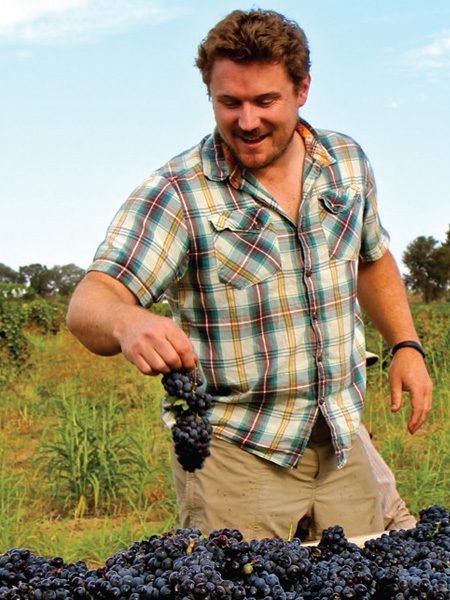In the past decade, Provence ushered in a rosé boom lit by a pale pink. Sales of the southern French pink claimed nearly 30 percent of all retail rosé sales by volume (and 43 percent by value) in the US in 2016. Whether wine drinkers are choosing based on taste or reputation, the popularity of pale Provençal pinks on the marketplace has had one clear effect: light-colored rosés have become de rigueur—to the point where vintners feel pressured to keep colors light.
Morgan Twain-Peterson of Bedrock Wine Co. in California felt this pressure with his Ode to Lulu Rosé in 2013. Thanks to the effects of the drought, he says, “that vintage was a dark year for wines across the board, and [Ode to Lulu] was two or three shades darker. We had trouble selling through the wine because of the color. We still take that into account when we make it.”
Although the color of rosé usually says more about the varieties chosen to make it than the wine’s taste or complexity, Twain-Peterson and other winemakers have found that wine drinkers assume the color communicates quality. But Twain-Peterson, for his part, is ready to go only so far to keep the color light. “What sets Lulu apart,” he says, “is that we are picking old vines for it. The youngest vines were planted in 1922. Everything else is from the 1880s and 1890s.” The result is a wine of innate complexity, regardless of color, and plenty of freshness.
Other vintners are taking inspiration from southern Italy (like Ryme Cellars, with their Gianelli Vineyard Aglianico Rosé) and parts of France other than Provence, like Chinon (Etxea Cabernet Franc Rosé), and Savoie (Jaimee Motley Mondeuse Rosé), where there’s a history of rosé from other varieties across a broad range of pinks.
A Broader Spectrum
Or Portugal: Nathan Roberts and Duncan Arnot Meyers began working with touriga nacional grown in California’s North Coast for their rosé in 2011. “That first year, we went directly to press with little skin contact, thinking it would make a dark wine. The color dropped out during fermentation. We had to add back red wine to make it look like rosé,” Arnot Meyers says. In every year since, the duo has put the fruit through the crusher for more color.
“The juice is almost black but [the color] drops out pretty well,” he says. By bottling, the rosé has become a deep copper. In 2013, it was copper tinged with black, an example of an unpredictable challenge of making rosé. But color is only one of several concerns when making rosé; capturing a balance of flavor and structure while avoiding bitterness or harsh tannins can be tricky, especially with lesser-known varieties that few others have fermented pink.
“The picking decision is everything,” says Arnot Meyers. But with pink wine, it can be hard to know when to pick for both freshness and flavor. “When you are picking for rosé, there is so much acid [in the fruit] that discerning its flavor is a bit intangible. That first year [with touriga nacional], we just had to commit to picking with really high acid. Then, after ferment, we had gorgeous flavor. We trust that experience now.”


In 2016, John Lockwood of Enfield Wine Co. began making Foot Tread Rosé. It’s a 100 percent whole-cluster pinot noir, foot stomped and left to macerate on its skins overnight. The result is a transparent ruby rosé with impressive flavor and lightly tactile structure that earned him a spot on the glass list at Mister Jiu’s in San Francisco.
At Proxi in Chicago, Jennifer Wagoner pours Forlorn Hope Queen of the Sierras Rosé by the glass. It combines barbera and zinfandel for a relatively dark pink with vibrant acidity. “It’s been doing well as a segue into wines that may not be on everyone’s radar,” she says. “As long as we convey the style to our guests, the intrigue of these sorts of unexpected wines, and their well-balanced, food-friendly nature, keeps them on the list.”
Historical Precedents
Some deeper-hued rosés have a following and a history. In fact, if California has a heritage rosé it is Heitz Cellars Grignolino Rosé. Joe Heitz began making the wine after purchasing his first estate vineyard in 1961, an eight-acre parcel planted to grignolino. It’s a California wine with more than 50 years of history, from one of the state’s least-known varieties. And it runs counter to current trends. The wine glows an almost fluorescent pink, and bursts with flavors of alpine strawberries and citrus. Over the years, it has garnered a cult-like status.
In another sign of pink longevity, Randall Grahm has made rosé at Bonny Doon since 1981. His early renditions relied on mourvedre until, in 1984, Grahm began making Vin Gris de Cigare as a Rhône-style blend. It remains one of Bonny Doon’s bestsellers. Its color has oscillated by vintage, sometimes as light as a delicate crepe, in other vintages more of a rouge—the current rendition a deep salmon pink—but its sales have persisted regardless of trend.
Yet, when he introduced an almost incandescent ruby rosé made with tannat and cabernet franc in 2015, it proved harder to sell. Grahm opted not to make it again.
Perhaps he was just a little too early. Though pale pink still rules, the latest crop of US rosés offers complexity, and the wines are no less refreshing, giving drinkers more alternatives in the world of pinks.
This story was featured in W&S August 2018.
Based in Sonoma, Elaine Chukan Brown serves as the American specialist for JancisRobinson.com. Their work also appears in World of Fine Wine, the fourth edition of the Oxford Companion to Wine and on their own site, WakawakaWineReviews.com. Prior to writing about wine, Chukan Brown was a philosophy professor specializing in ethics and social politics.
This story appears in the print issue of August 2018.
Like what you read? Subscribe today.
















